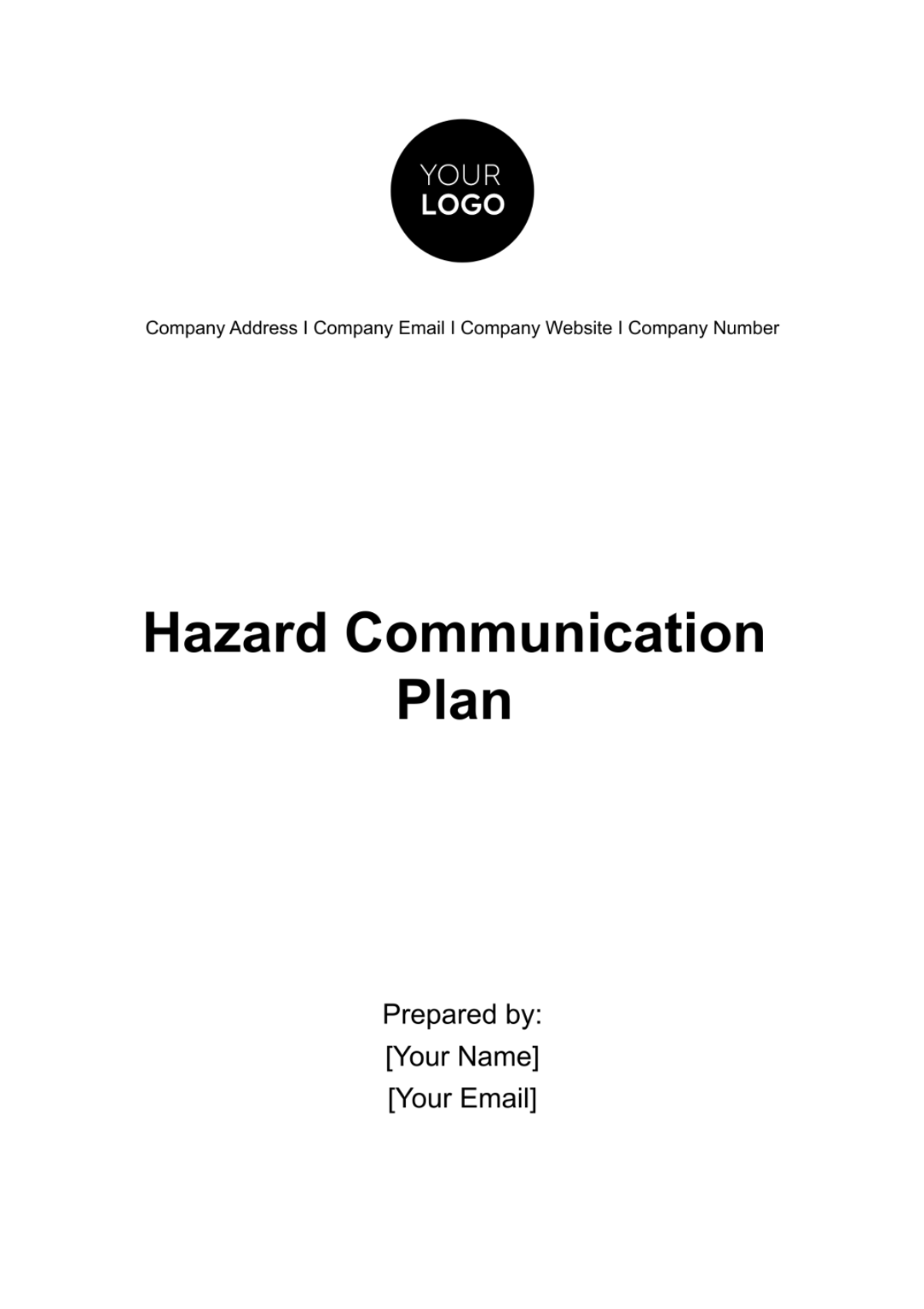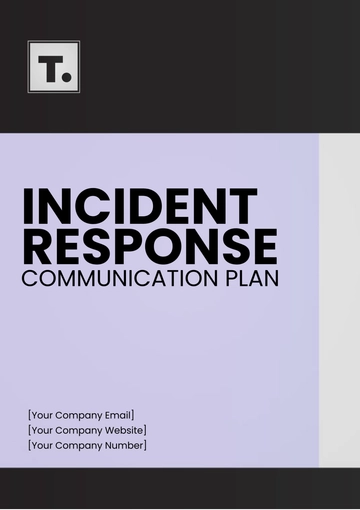Free Hazard Communication Plan

Introduction
A. Purpose
The purpose of this Hazard Communication Plan is to ensure the safety of all employees and visitors of [Your Company Name] by effectively communicating information about hazardous chemicals used in our workplace. This includes but is not limited to chemicals used in production processes, cleaning materials, and any other substances that pose potential health, safety, or environmental risks.
B. Scope
This comprehensive plan covers all hazardous chemicals that are present in our workplace, as defined by the Occupational Safety and Health Administration (OSHA) Hazard Communication Standard (HCS) [29 CFR 1910.1200]. It applies to all employees, contractors, and visitors who may come into contact with hazardous chemicals while on the premises of [Your Company Name].
C. Responsibilities
[Your Name], as the designated Safety Officer, is responsible for the oversight, implementation, and continuous improvement of this plan. [Your Name] can be reached at [Your Email] for any questions or concerns related to hazard communication.
All employees, including supervisors and managers, are responsible for familiarizing themselves with the contents of this plan, attending required training sessions, and adhering to safe chemical handling practices in their respective roles.
Visitors and contractors are expected to follow safety instructions, including chemical safety guidelines, while on [Your Company Name]'s premises.
Hazard Classification
A. Identification of Hazards
Hazardous chemicals in our workplace are identified through a rigorous process that involves a combination of manufacturer information, chemical testing, and expert assessment. Hazard identification takes into account the following factors:
Chemical Properties: We consider physical properties such as flammability, reactivity, and corrosivity, as well as health hazards like toxicity, carcinogenicity, and skin sensitization.
Manufacturer's Information: We rely on the information provided by chemical manufacturers and suppliers, including Safety Data Sheets (SDS), to understand the hazards associated with specific chemicals.
Expert Assessment: Our in-house safety experts conduct additional assessments when needed to determine the nature and extent of hazards posed by chemicals that may not be fully covered in manufacturer documentation.
B. Labeling Requirements
All hazardous chemicals used and stored in our workplace are required to have appropriate labels that convey essential information. Labels are designed to be clear, visible, and prominently displayed on chemical containers. The labeling requirements include:
Product Identifier: Each chemical container is labeled with a unique product identifier that matches the identifier on the corresponding SDS. This identifier helps employees quickly identify the chemical and cross-reference it with safety information.
Hazard Pictograms: Hazard pictograms are used to provide a visual representation of the type of hazard associated with the chemical. Common pictograms include those for flammable materials, corrosive substances, and health hazards. These are displayed prominently on labels.
Signal Words: Signal words such as "Danger" and "Warning" are used to convey the relative severity of the hazard. "Danger" indicates a more severe hazard, while "Warning" indicates a less severe one.
Hazard Statements: Hazard statements describe the nature of the hazard. For example, "Causes skin irritation" or "Highly flammable liquid and vapor."
Precautionary Statements: These statements provide information on how to safely handle the chemical, including recommended protective measures.
Supplier Information: Labels also include the name, address, and contact information of the chemical supplier or manufacturer.
C. Safety Data Sheets (SDS)
Safety Data Sheets (SDS) serve as comprehensive sources of information about hazardous chemicals. They are essential for providing employees with in-depth knowledge about the properties and hazards of each chemical. Key aspects of SDS management at [Your Company Name] include:
SDS Collection: We maintain a central repository of SDS for all hazardous chemicals used on-site. This repository is easily accessible to all employees and is continuously updated to reflect the latest information.
Accessibility: Employees have immediate access to SDS during their work shifts, either physically or electronically. SDS are available both in hard copy near the storage area and through our digital document management system.
Updating SDS: We monitor SDS for any updates or revisions provided by chemical manufacturers. When updated SDS are received, they are promptly reviewed and replaced to ensure that employees always have the most current safety information available.
Employee Training
A. Training Program
At [Your Company Name], employee training is a fundamental component of our Hazard Communication Plan. Our training program is designed to equip all employees who may be exposed to hazardous chemicals with the knowledge and skills necessary to work safely. The key elements of our training program include:
Orientation Training: All new employees receive comprehensive hazard communication training during their orientation. This training introduces them to the hazards associated with chemicals in our workplace, the location of safety data sheets (SDS), and the importance of labeling.
Annual Refresher Training: To ensure that our employees remain well-informed and up-to-date, we conduct annual refresher training sessions. These sessions reinforce hazard awareness, safe handling practices, and emergency response procedures.
Task-Specific Training: Employees receive task-specific training relevant to their roles and responsibilities. This training addresses hazards specific to their job tasks and includes guidance on using personal protective equipment (PPE) and handling chemicals safely.
B. Training Content
Our hazard communication training content covers the following critical areas:
Chemical Hazards: Employees are educated about the various hazards associated with chemicals, including but not limited to physical hazards (flammability, reactivity), health hazards (toxicity, carcinogenicity), and environmental hazards.
Safe Use and Handling: We emphasize safe handling practices, proper storage procedures, and measures to prevent chemical exposures. This includes guidance on the use of PPE, such as gloves, eye protection, and respiratory protection when necessary.
Emergency Response: Employees are trained on the appropriate steps to take in case of chemical spills, releases, or exposures. This includes evacuation procedures, first aid measures, and how to report incidents.
Label Interpretation: Training includes guidance on how to interpret chemical labels, including product identifiers, hazard pictograms, signal words, hazard statements, and precautionary statements.
Safety Data Sheets (SDS): Employees learn how to access and utilize SDS effectively. This includes understanding the sections of an SDS and knowing where to locate them in the workplace.
C. Training Records
We maintain detailed records of all hazard communication training conducted at [Your Company Name]. These records include:
Employee Names: A list of employees who have received hazard communication training.
Training Dates: Dates on which training sessions were conducted, including initial orientation training and annual refresher training.
Training Content: Records indicate the topics covered during each training session, ensuring that all required areas are addressed.
Instructor Names: Names of the trainers or instructors responsible for delivering the training.
Chemical Inventory
A. Inventory Management
Maintaining an accurate and up-to-date chemical inventory is essential to our hazard communication efforts. Our inventory management procedures include:
Regular Inspections: We conduct regular inspections of chemical storage areas to identify and document the presence of new chemicals, as well as changes in quantities and locations.
Chemical Procurement: When procuring new chemicals, our procurement team ensures that relevant information, including SDS, is obtained and reviewed before the chemical is introduced into the workplace
Documentation: We maintain detailed records of the chemicals used, stored, or transported within our facility. These records include the product identifier, quantity on hand, and the location of each chemical.
B. Product Identifier
Each chemical in our inventory is labeled with a unique product identifier. This identifier is consistent with the product identifier provided on the corresponding safety data sheet (SDS). The product identifier includes:
Chemical Name: The full chemical name or a recognized abbreviation.
Chemical Manufacturer or Supplier: The name and contact information of the manufacturer or supplier.
Lot or Batch Number: If applicable, a lot or batch number to facilitate traceability.
C. Quantity on Hand
To maintain safe storage conditions and prevent overstocking, we closely monitor the quantity of each hazardous chemical on hand. Our procedures for tracking quantity include:
Regular Updates: Quantity information is regularly updated to reflect changes in usage and replenishment.
Maximum Storage Limits: We establish maximum storage limits for certain hazardous chemicals and adhere to these limits to prevent overcrowding and promote safety.
Expiration Dates: Chemicals with limited shelf life are monitored for expiration, and appropriate disposal or replacement measures are taken when necessary.
Safety Data Sheets (SDS) Management
A. SDS Collection
At [Your Company Name], we place significant importance on the collection and organization of Safety Data Sheets (SDS) for all hazardous chemicals used in our workplace. Our SDS management practices include:
Centralized Repository: We maintain a central repository where all SDS are organized and stored. This repository is easily accessible to all employees, and it is the primary source for retrieving safety information.
Supplier Cooperation: We work closely with our chemical suppliers to ensure that we receive the most up-to-date SDS for the products we use. Suppliers are required to provide SDS as part of their service agreements.
Digital Access: In addition to physical copies of SDS, we provide digital access to electronic versions of SDS through our secure intranet. This ensures that employees can quickly retrieve SDS even when away from the storage area.
B. Accessibility
Accessibility to SDS is a cornerstone of our hazard communication efforts. We ensure that employees have immediate access to SDS during their work shifts. Key practices include:
Physical Access: Physical copies of SDS are kept near the areas where hazardous chemicals are stored and used. They are clearly labeled for easy identification.
Electronic Access: We maintain an electronic database of SDS, which is accessible from any computer on our network. This ensures that employees can access SDS quickly, even if they are not near the physical storage area.
24/7 Availability: Electronic access is available 24/7 to accommodate various work schedules and emergency situations.
C. Updating SDS
We are committed to keeping our SDS information accurate and up-to-date. Our practices for updating SDS include:
Regular Review: We regularly review SDS for all hazardous chemicals in our inventory to ensure that they are current and compliant with regulatory requirements.
Receiving Updates: When we receive updated SDS from chemical manufacturers or suppliers, we promptly review and replace the outdated versions in our repository.
Employee Notifications: Employees are informed of any significant changes to SDS that may affect their safety or job responsibilities. This ensures that everyone remains aware of the most recent hazard information.
Hazardous Chemical Use Procedures
A. Safe Handling Practices
Ensuring the safe handling of hazardous chemicals is a top priority at [Your Company Name]. We have established comprehensive safe handling practices, which include:
Employee Training: All employees who work with or near hazardous chemicals receive thorough training on safe handling practices. This training covers topics such as proper use of personal protective equipment (PPE), safe transfer and dispensing of chemicals, and minimizing exposure risks.
Engineering Controls: We implement engineering controls, such as ventilation systems and containment measures, to minimize the release of hazardous chemicals into the workplace.
Use of PPE: Employees are provided with and required to use appropriate PPE, including gloves, eye protection, respiratory protection, and protective clothing, based on the specific hazards associated with the chemicals they handle.
B. Storage Guidelines
Our storage guidelines are designed to prevent accidents and ensure the safe storage of hazardous chemicals. Key practices include:
Segregation: Hazardous chemicals are stored separately from incompatible substances to prevent chemical reactions or contamination.
Proper Labeling: Chemical containers are clearly labeled with the product identifier, hazard warnings, and appropriate storage instructions.
Ventilation: Storage areas are equipped with adequate ventilation systems to control the buildup of fumes and vapors.
Secure Storage: Access to chemical storage areas is restricted to authorized personnel only to prevent unauthorized handling or tampering.
C. Emergency Procedures
Emergency procedures are vital for responding to incidents involving hazardous chemicals. Our emergency procedures include:
Spill Response: Employees are trained in spill response procedures, including containment, cleanup, and disposal. Spill kits with appropriate materials are readily available.
Emergency Equipment: Emergency eyewash stations, safety showers, and fire extinguishers are strategically located in areas where hazardous chemicals are used or stored.
Evacuation Plans: We have evacuation plans in place in case of chemical emergencies, and employees are trained on evacuation routes and assembly points.
First Aid: Employees are trained in providing basic first aid for chemical exposures, including eye rinsing and skin decontamination.
Communication of Hazards
A. Labels and Warnings
Effective communication of chemical hazards is crucial for employee safety. Our labeling and warning practices include:
Label Inspection: Labels on chemical containers are regularly inspected to ensure they are intact and legible. Damaged or missing labels are promptly replaced.
Pictograms: We use standardized hazard pictograms as per OSHA requirements to provide visual representations of hazards. Pictograms are displayed prominently on labels for easy recognition.
Signal Words: Labels include signal words such as "Danger" or "Warning" to convey the severity of the hazard. "Danger" is used for more severe hazards, while "Warning" indicates a less severe hazard.
Hazard Statements: Hazard statements on labels provide concise information about the nature of the hazard, such as "Causes skin irritation" or "Flammable liquid."
Precautionary Statements: Labels also contain precautionary statements that guide employees on safe handling practices, first aid measures, and emergency response actions.
Supplier Information: Contact information for the chemical supplier or manufacturer is included on labels for employees to reach out for additional information or assistance.
B. Safety Signage
In addition to labels on individual chemical containers, safety signage is used in areas with potential chemical hazards. Our safety signage practices include:
Placement: Safety signs are strategically placed near hazardous chemical storage areas, workstations, and other locations where exposure is possible.
Content: Signage includes hazard pictograms, signal words, and concise messages to alert employees to specific dangers and precautions.
Visibility: Signs are designed to be highly visible, using contrasting colors and fonts for maximum impact.
C. Reporting Incidents
Employees are encouraged to promptly report any chemical incidents, exposures, or safety concerns. Reporting procedures include:
Incident Reporting Form: We provide a standardized incident reporting form that employees can easily fill out to document incidents.
Supervisor Notification: Employees are required to notify their immediate supervisor or manager in case of a chemical incident or exposure.
Investigation and Follow-Up: Reported incidents are thoroughly investigated, and corrective actions are taken to prevent similar incidents in the future.
Emergency Response
A. Reporting Emergencies
In the event of a chemical emergency, prompt reporting is crucial. Our emergency reporting procedures include:
Immediate Notification: Employees are trained to immediately report chemical emergencies to the designated emergency contact or supervisor.
Contact Information: Emergency contact information, including phone numbers for relevant personnel and authorities, is posted in easily accessible locations.
B. Evacuation Procedures
Emergency evacuation procedures are essential for employee safety during chemical emergencies. Our evacuation procedures include:
Evacuation Plans: Detailed evacuation plans are in place for various types of chemical emergencies. These plans outline evacuation routes, assembly points, and communication methods.
Emergency Drills: We conduct regular emergency evacuation drills to ensure that employees are familiar with the procedures and can evacuate safely in a real emergency.
C. First Aid and Medical Assistance
Providing immediate first aid and medical assistance in the event of chemical exposures is a priority. Our first aid and medical assistance procedures include:
First Aid Kits: First aid kits are available in locations where hazardous chemicals are used. They contain supplies for treating chemical exposures, such as eyewash solutions and burn dressings.
Medical Assistance: Employees are trained to seek medical attention promptly if they experience chemical exposure or related health symptoms. We provide information on nearby medical facilities and contacts.
Review and Revision of the Plan
A. Periodic Review
This Hazard Communication Plan undergoes a thorough review annually to ensure its continued effectiveness and compliance with regulatory standards. The review process includes:
Documentation Review: All records related to chemical inventory, training, incident reports, and SDS management are reviewed to identify any areas that require updates or improvements.
Regulatory Compliance: We ensure that our plan aligns with the latest OSHA requirements and other relevant regulations.
B. Plan Updates
Any necessary updates or revisions to the Hazard Communication Plan are made promptly. Updates may be triggered by changes in chemicals used, newly identified hazards, or regulatory modifications. Key steps in the update process include:
Documentation: All revisions and updates are documented, including the reasons for the changes and the individuals responsible for implementing them.
Communication: Updated versions of the plan are communicated to all relevant employees to ensure awareness of changes and compliance with the updated procedures.
- 100% Customizable, free editor
- Access 1 Million+ Templates, photo’s & graphics
- Download or share as a template
- Click and replace photos, graphics, text, backgrounds
- Resize, crop, AI write & more
- Access advanced editor
Craft effective hazard communication strategies with Template.net's Hazard Communication Plan Template. This editable and customizable template, accessible via our Ai Editor Tool, simplifies the process of creating comprehensive plans to inform and protect employees from workplace hazards. Ensure compliance and safety with ease using Template.net's innovative solutions.





























